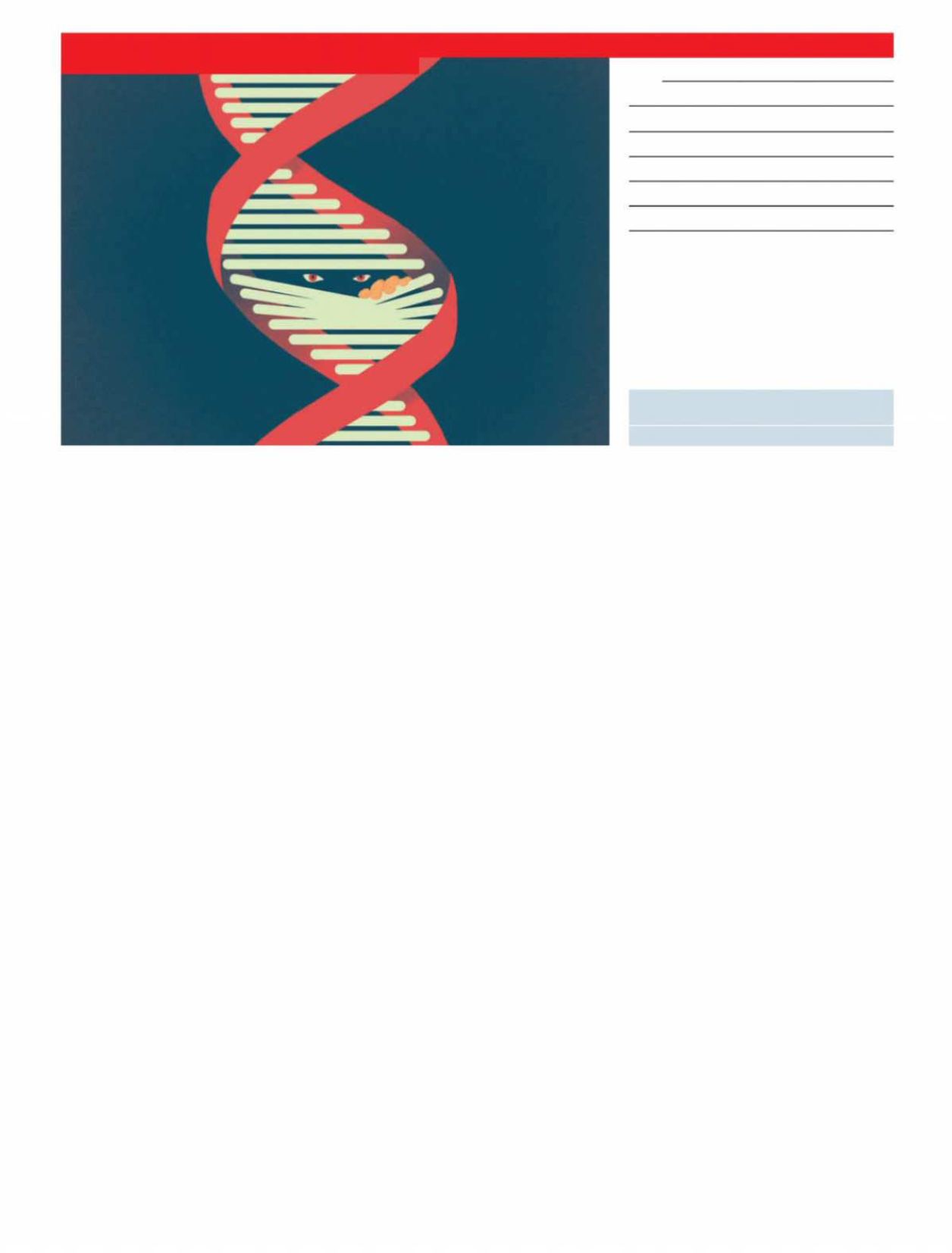
The Economist
May 5th 2018
75
For daily analysis and debate on science and
technology, visit
Economist.com/scienceO
N APRIL 24th police in California an-
nounced the arrest of Joseph De-
Angelo. Mr DeAngelo stands accused of
eight counts ofmurder. OnApril 27th some
intriguing details emerged of what had
prompted the arrest. The starting-point
was genetic material recovered from the
crime scenes. Though this directly
matched no
DNA
held in a police database,
analysis of it led investigators all the way
back to the 1800s, to Mr DeAngelo’s great-
great-great grandparents. The trail they fol-
lowed allegedly links Mr DeAngelo to
crimes committed around Sacramento in
the 1970s and 1980s by an unknown man
who acquired the nickname of the Golden
State Killer, and who murdered at least 12
people and rapedmore than 50.
That a link to distant ancestors could
lead to an arrest is testament to the power
of modern genomics. Investigators first
uploaded Mr DeAngelo’s genetic profile to
a website called
GED
match. This allows
anyone to use his or her own genetic pro-
file to search for family connections.
GED-
match’s database turned out to hold pro-
files, returned as weak matches, which
looked as if they had come from distant
cousins of the Golden State Killer.
GED-
match encourages uploaders to include
their real name with their genomes, and
the investigators were able to trace back
through the matches’ parents and grand-
parents to find their most recent common
ancestor. Then, having moved backward
certain diseases, for example, or informa-
tion about paternity, that the relative in
questionmight ormight not want to know,
and might or might not want to become
public.Who should be allowed to see such
information, andwhomight have a right to
see it, are questions that need asking.
They are beginning to be asked. In 2017
the Court of Appeal in England ruled that
doctors treating people with Huntington’s
chorea, an inherited fatal disease of the
central nervous system the definitive diag-
nosis of which is a particular abnormal
DNA
sequence, have a duty to disclose that
diagnosis to the patient’s children. The
children of a parent who has Huntington’s
have a 50% chance of inheriting the illness.
In this case, a father had declined to dis-
close his newly diagnosed disease to his
pregnant daughter. Shewas, herself, subse-
quently diagnosedwith Huntington’s. She
then sued the hospital, on the basis that it
was her right to know of her risk. Had she
known, she told the court, she would have
terminated her pregnancy.
That is an extreme case. But intermedi-
ate ones exist. For example, certain vari-
ants of a gene called
BRCA
are associated
with breast cancer. None, though, is 100%
predictive. If someone discovers that he or
she is carrying such a variant, should that
bring an obligation to inform relatives, so
that they, too, may be tested? Or does that
risk spreading panic to no good end?
It may turn out that such worries are
transient. As the cost ofgenetic sequencing
falls, the tendency of people to discover
their own genetic information, rather than
learning about it second-hand, will in-
crease. That, though, maybringabout a dif-
ferent problem, of genetic snooping, in
which people obtain the sequences of oth-
ers without their consent, from things like
discarded coffee cups. At that point genetic
privacy reallywill be a thing of the past.
7
in time, they moved forward again, look-
ing for as many as possible of this ances-
tor’s descendants. Using newspaper clip-
pings, census records and genealogy
websites, they discovered some 25 family
trees stretching down from the common
ancestor. On its own, the tree on whichMr
DeAngelo appears has1,000members.
After that, old-fashioned sleuthing took
over. From these thousands of descen-
dants, the detectives found two who had
had connections with Sacramento at the
time the Golden State Killings were taking
place. One was eliminated from the inves-
tigation by further
DNA
tests of a family
member. The other, Mr DeAngelo, was ar-
rested after police had tested the
DNA
on
an itemhe had discarded.
Serial privacy
If a serial killer really has been caught us-
ing these methods, everyone will rightly
applaud. But the power of forensic geno-
mics that this case displays poses concerns
for those goingabout their lawful business,
too. It bears on the question of genetic pri-
vacy—namely, how much right people
have to keep their genes to themselves—by
showing that noman orwoman is a genet-
ic island. Information about one individ-
ual can reveal information about others—
and not just who is related towhom.
With decreasing degrees of certainty,
according to the degree of consanguinity, it
can divulge a relative’s susceptibilities to
Genomes and privacy
No hiding place
American police have used genealogy tomake an arrest in amurder case
Science and technology
Also in this section
76 Nouns, verbs and anger
76 Neanderthal art
76 Improving desalination
77 Breastfeeding and working mothers
78 Policing modern slavery
РЕЛИЗ ПОДГОТОВИЛА ГРУППА "What's News"
VK.COM/WSNWS







